This easy Southern Fried Fish recipe will take your taste buds on a flavor-packed adventure! The simple recipe features fresh fish fillets marinated in zesty buttermilk, enveloped in a tantalizing blend of Creole-seasoned cornmeal and flour, and expertly deep-fried to achieve a glorious, golden-brown crunch.
Pair your fried fish with classic sides such as crunchy American Coleslaw, Creamy Cheese Grits, and delectable Southern Hush Puppies, and you will have an authentic Southern fish fry menu that will please even your pickiest eaters!
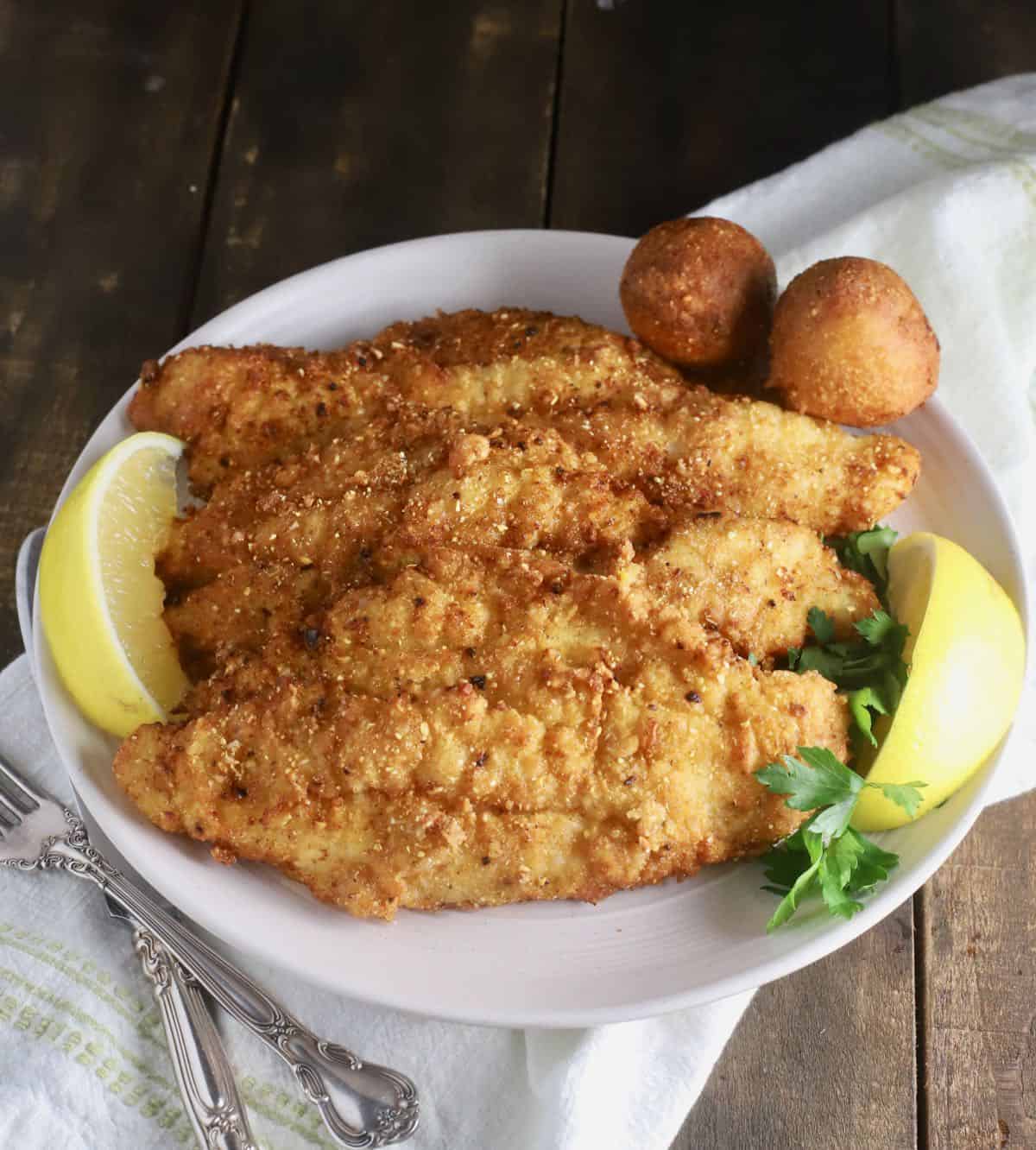
In the South, grouper, mullet, and fried catfish reign supreme and are the most common fried fish seen at fish fries and seafood restaurants. Deep-fried with a blissfully crunchy coating, they taste sweet and mild, and the fillets are always juicy and tender.
If you like fried seafood or seafood platters as I do, I know you will also love my Fried Grouper, Fried Shrimp, Buffalo Fried Shrimp, Deviled Crab, Fried Crab Claws, Fried Whole Catfish, and Fried Oysters recipes.
Jump to:
- Why You’ll Love This Deep Fried Fish
- Fried Fish Recipe Ingredients
- How to Make Fried Fish
- Best Fried Fish Recipe Tips
- Fried Fish Recipe Variations
- What to Pair With Deep Fried Fish
- How to Store Deep Fried Fish
- Frequently asked questions:
- More seafood recipes:
- More Favorites from Grits and Pinecones
- 📋 Recipe:
Why You’ll Love This Deep Fried Fish
- It’s easy enough for a beginner cook because my simple step-by-step directions and video walk you through the entire process.
- Like my blackened cod seasoning, my unique Creole-seasoned cornmeal breading delivers an irresistible medley of spices, transforming every bite into a captivating experience you won’t find anywhere else.
- I take the mystery out of deep-frying and offer tips to keep grease splatter to a minimum.
Fried Fish Recipe Ingredients
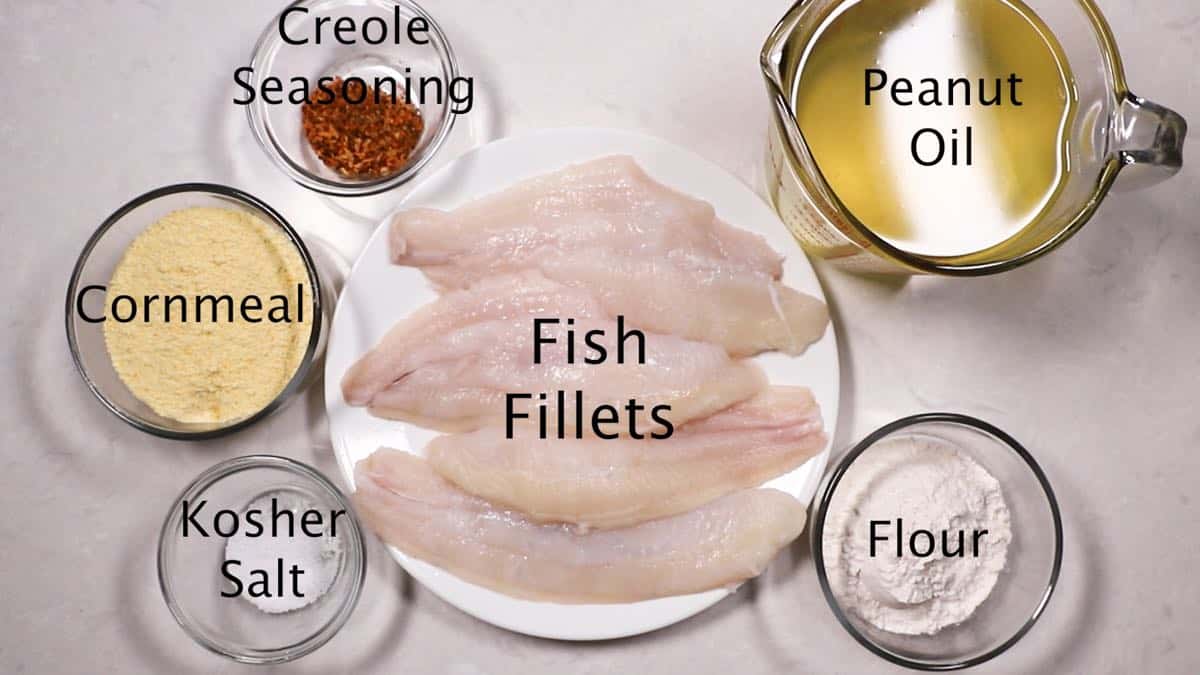
You only need a few ingredients to make Southern Fried Fish, and they are:
- Fish fillets – are at the heart of this dish. Be sure your fillets are fresh and don’t smell fishy. Fresh fish should smell like a mild sea breeze.
- Buttermilk – an essential ingredient that adds flavor and helps ensure that the cornmeal coating adheres to the fillets. (Not pictured)
- Cornmeal – you can’t have cornmeal coating without cornmeal, which gives these fried fish fillets their crunch.
- All-purpose flour – just a bit of flour helps ensure that the cornmeal coating sticks and does its job of sealing in the fillets’ delicious juices.
- Creole seasoning – because a bit of heat and spice makes everything tastier. If you would like a bit more heat, substitute Cajun seasoning.
- Kosher salt – enhances all of the flavors in this recipe.
- Peanut oil – is my recommended oil for frying because of its high smoke point and neutral taste. You can also use canola oil.
Complete measurements are listed in the recipe card below.
The best fish for frying:
Freshwater fish include catfish along with brim, crappie, perch, and bass.
Saltwater fish include Spanish mackerel, grouper, flounder, tilapia, cod, whiting, speckled trout, haddock, mullet, and red snapper.
The best oil for frying:
I always use peanut oil because it has a high smoke point. The smoke point is the temperature at which the oil begins to break down and smoke.
Other good oils with a high smoke point include canola, corn, sunflower, safflower, grapeseed, and avocado. Save your expensive olive oil for other uses.
How to Make Fried Fish
- Pour the buttermilk into a shallow container or large sealable plastic bag and add the fillets. Allow them to soak for about 30 minutes.
- While the fillets are soaking, place the cornmeal, flour, Creole seasoning, and salt in a large shallow pie plate or bowl and use a whisk or fork to combine.
- Take a fillet and let any excess buttermilk drain off, then dredge in the cornmeal mixture. Make sure the entire fillet is coated. Place on a wire rack to rest. Repeat with the other fillets.
- Place a cast-iron skillet or Dutch oven over medium-high heat and add the peanut oil.
- Use a candy or deep-fry thermometer to test the oil temperature and bring it up to 375° F. When the oil has reached the correct temperature, carefully add the first fillet. If the temperature drops, wait until it has come back up before adding another fillet. Do not crowd them and only cook one or two fillets at a time. Keep the heat at 375° F by increasing or decreasing the heat.
- Let the fillets fry for two to three minutes or until they are floating and golden brown. Use a spider skimmer or fish spatula to remove the fillets from the oil.
- Place on a wire cooling rack to drain. Repeat with the other fillets.
- Serve immediately with catsup, tartar sauce, remoulade sauce, or cocktail sauce.
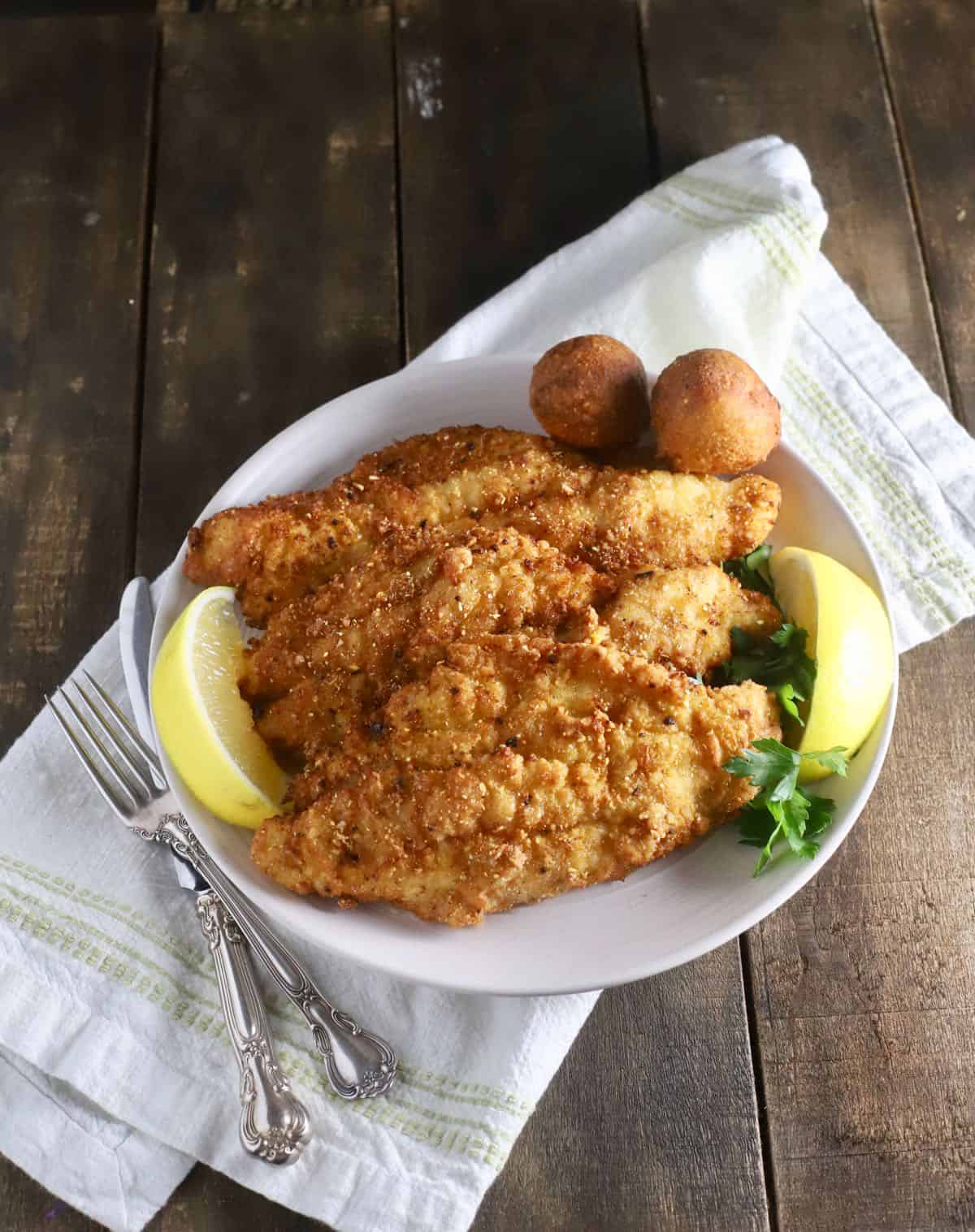
Best Fried Fish Recipe Tips
- Letting the fish fillets sit with their coating on a wire rack for a few minutes before cooking helps the cornmeal coating stay put while the fillet is frying for the ultimate crispy coating.
- I often recommend making your own buttermilk by mixing milk with vinegar or lemon juice for baking, but you need to use real buttermilk for the best flavor in this recipe.
- If you want to keep grease splatter down to a minimum, use a large high-sided stockpot or Dutch oven instead of a cast-iron skillet, and use a wire screen splatter guard while your fish is frying.
- When purchasing fish, try to find boneless, skinless fillets about a half-inch thick. Fresh is best, but frozen works too. If your fillets are frozen, let them thaw before using them, and pat dry with a paper towel before you soak them in the buttermilk. Water and hot oil do not play well together.
- If your fillets are large, and especially if this is your first time frying fish, I recommend that you cut them up into small pieces or nuggets. They will be easier to manage.
Top tip:
For the best results, don’t skip the step of letting your fillets soak in buttermilk before coating them with the cornmeal mixture.
Fried Fish Recipe Variations
There are several methods and variations for preparing fried fish; here are a few ideas:
- For a healthier alternative, try oven-fried fish instead of deep-fried. Coat the fillets with a mixture of mayonnaise and herbs, and top with panko. Place on a wire baking rack and bake in a 300° F oven for about 30 minutes.
- Instead of deep-frying, coat your fish in flour and pan-fry it in a small amount of oil in a skillet.
- Instead of cornmeal and flour, make pecan-crusted fish fillets. Coat the fillets in a mixture of mayonnaise and Creole seasoning, then dredge them in panko and finely chopped pecans. Pan fry, then finish in the oven.
- Make beer-battered fish by dipping the fillets in a light and airy beer batter before frying.
- Substitute panko breadcrumbs for the flour and cornmeal breading and bake in the oven, pan-fry, or deep-fry.
- Use gluten-free flour, such as rice or almond flour, in your breading.
What to Pair With Deep Fried Fish
I almost always serve fried fish with either Cheese Grits or my Cheese Grits Casserole, and frequently also include my House Salad.
Other side dishes that pair well include Smoked Baked Beans, Fried Cabbage, Cucumber and Tomato Salad, Southern Potato Salad, Air Fryer Frozen French Fries, Corn Salad, Fried Potatoes, Parmesan Smashed Potatoes, Smoked Sweet Potatoes, Purple Hull Peas, Twice Baked Potatoes, or my Southern Broccoli Salad.
Simple desserts are best and include choices such as Strawberry Sherbet, Orange Sherbet Ice Cream, Key Lime Mousse, and Strawberry Pie.
How to Store Deep Fried Fish
Leftover fried fish can be stored covered in your refrigerator for three to four days. The coating will not be as crispy as it was, but the fish will still be delicious.
Leftover fish can be used to make fish tacos or homemade fish cakes.
How to Reheat
An air fryer produces the best results. Preheat the air fryer to around 350° F. Place the leftover fillets in a single layer in the basket and reheat them for a few minutes until they are crispy.
You can also reheat leftovers in the oven by placing them on a wire rack over a baking sheet in a 350° F oven. Heat the leftovers until they are warmed, and the coating becomes crispy.
Leftovers can be reheated in a microwave but will not be crispy.
Frequently asked questions:
Placing the fried fish fillets on a wire rack instead of letting them drain on paper towels helps keep them crispy.
I prefer to fry my fish in a mixture of cornmeal and flour and think that makes the best coating. The flour helps it stick, and the cornmeal gives it that fried fish taste and crunch!
I always aim for between 360 and 375° F. If your temperature is too low, you will have greasy oil-soaked fish; if it’s too hot, the cornmeal coating will burn before the fish is cooked.
If you don’t already have a candy and deep-fry thermometer, do yourself a favor and get one. They are inexpensive and a game-changer when frying fish.
Absolutely! Save the original oil container. Once you’ve finished frying, let the oil cool completely. Place a fine-mesh strainer or, even better, a piece of cheesecloth over the mouth of a funnel to catch any bits of food, and slowly and carefully pour the oil back in. Store in a cool, dry place.
More seafood recipes:
We are lucky that fresh seafood is available year-round in our area. We take full advantage of this and often have seafood several times a week. If you like seafood as we do, I hope you will check out some of my other favorite fish recipes:
If you need more menu ideas, you can find all of my seafood recipes here
⭐ ⭐ ⭐⭐⭐ If you make this dish, please leave a comment and give this recipe a star rating. I would love to know how you liked it!
Thank you so much for visiting Grits and Pinecones; I hope you come back soon!
More Favorites from Grits and Pinecones
📋 Recipe:
Want to Save This Recipe?
Enter your email & I’ll send it to your inbox. Plus, get great new recipes from me every week!
By submitting this form, you consent to receive emails from Grits and Pinecones.
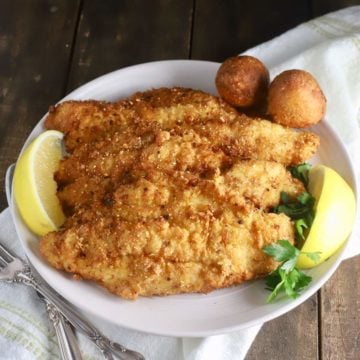
Southern Fried Fish Recipe
Ingredients
- 4 fish fillets, skinless, boneless, and about a half-inch thick
- 2 cups buttermilk
- 1 ¼ cups yellow cornmeal
- ¾ cup all-purpose flour
- 1 tablespoon Creole seasoning I like Zatarains
- 1 teaspoon kosher salt
- 1 quart peanut oil
Instructions
- Pour the buttermilk into a shallow container or large sealable plastic bag and add the fillets. Allow them to soak for about 30 minutes.
- While the fillets are soaking, place the cornmeal, flour, Creole seasoning, and salt in a large shallow pie plate or bowl and use a whisk or fork to combine.
- Take a fillet and let any excess buttermilk drain off, then dredge in the cornmeal mixture. Make sure the entire fillet is coated. Place on a wire rack to rest. Repeat with the other fillets.
- Place a cast-iron skillet or Dutch oven over medium-high heat and add the peanut oil.
- Use a candy or deep-fry thermometer to test the oil temperature and bring it up to 375°F. When the oil has reached the correct temperature, carefully add the first fillet; if the temperature drops, wait until it has come back up before adding another fillet. Do not crowd the fish, and only cook one or two fillets at a time. Keep the temperature at 375°F by increasing or decreasing the heat.
- Let the fish fry for two to three minutes or until they are floating and golden brown.
- Use a spider skimmer or fish spatula to remove the fillets from the oil. Place on a wire cooling rack to drain. Repeat with the other fillets.
- Serve immediately with catsup, tartar sauce, remoulade sauce, or cocktail sauce and your favorite side dishes.

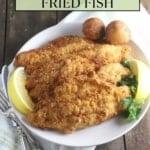
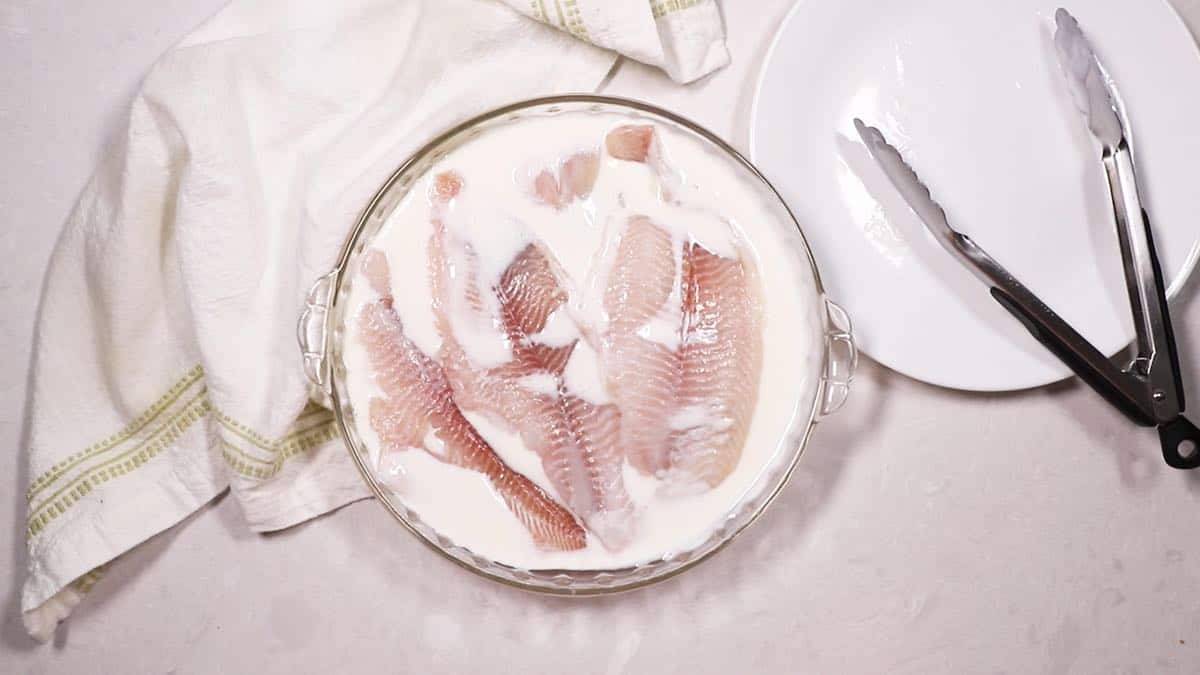
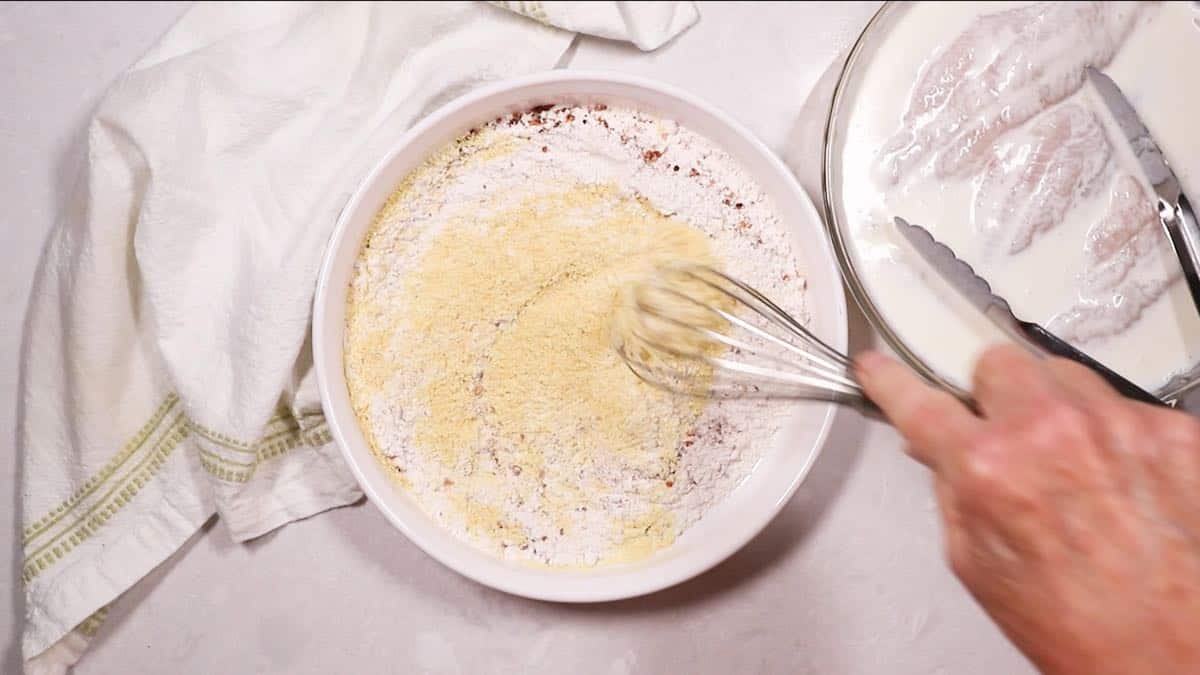
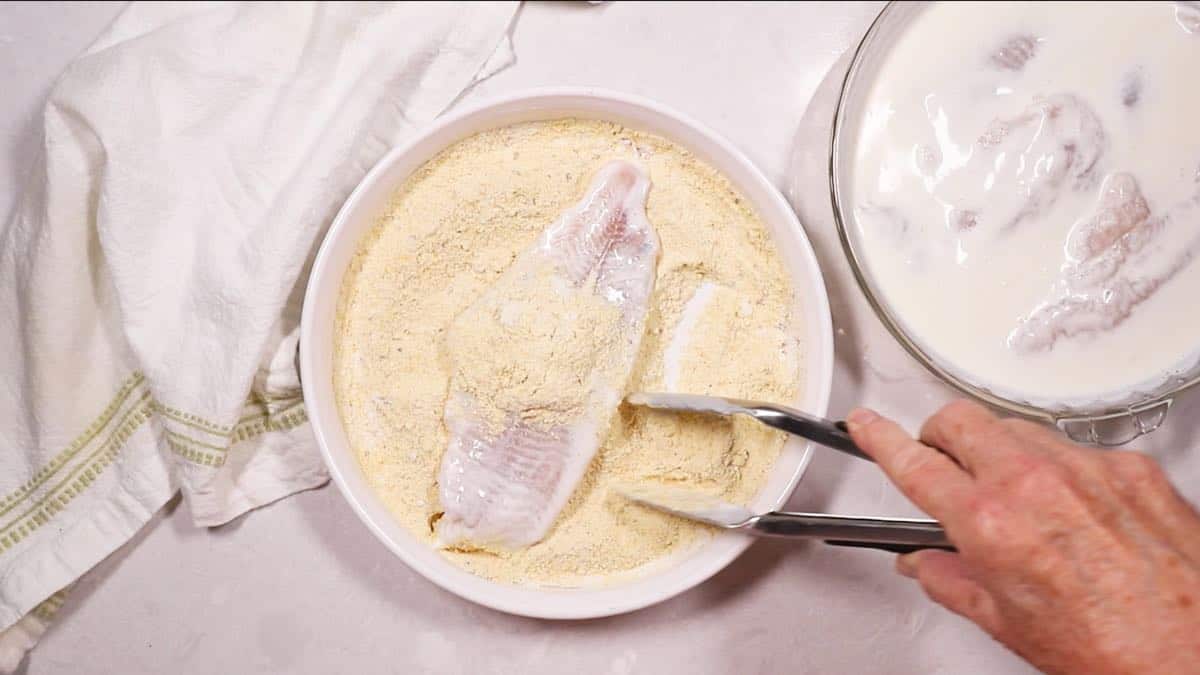
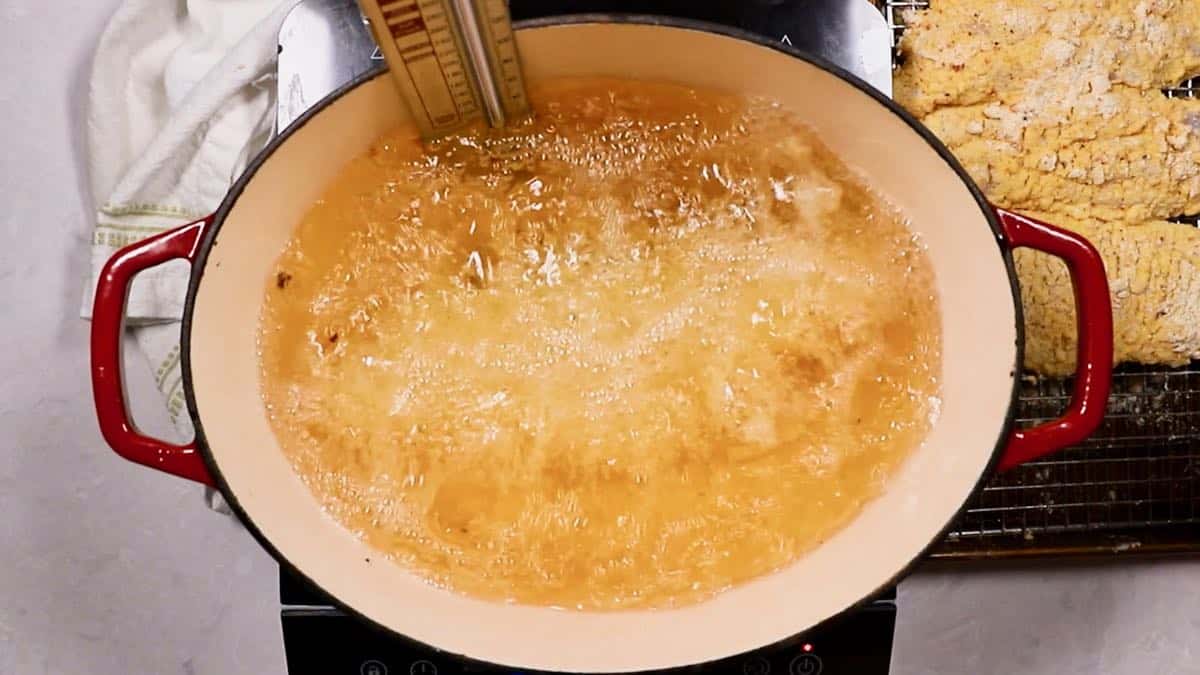
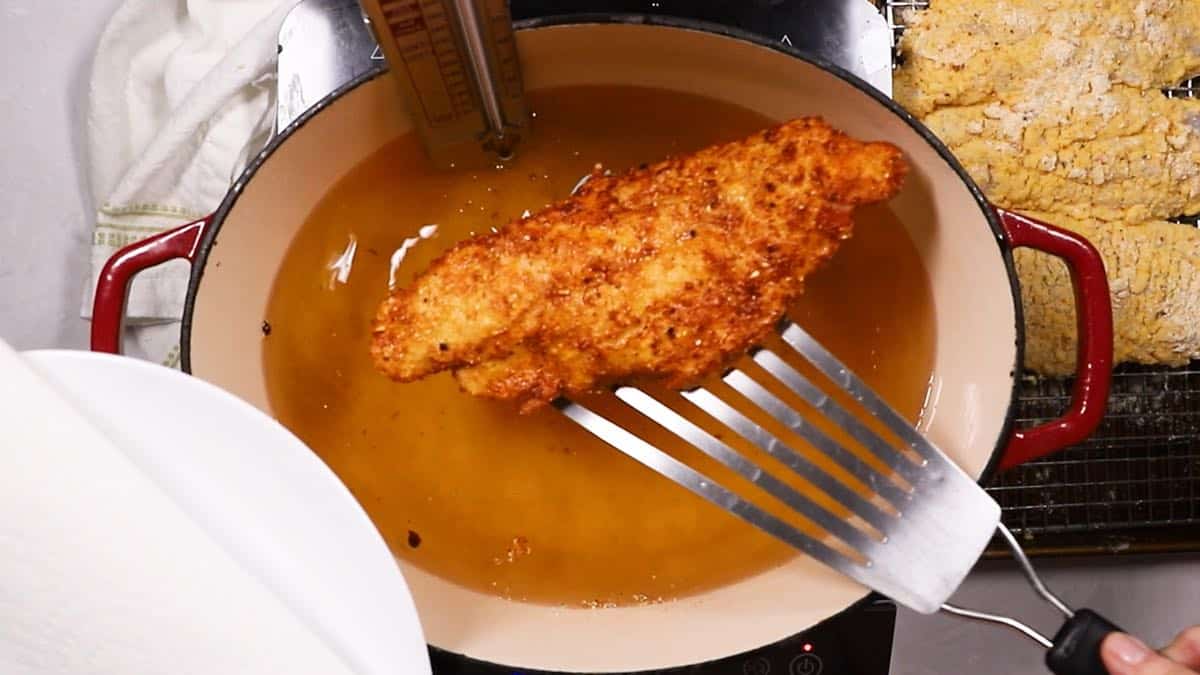
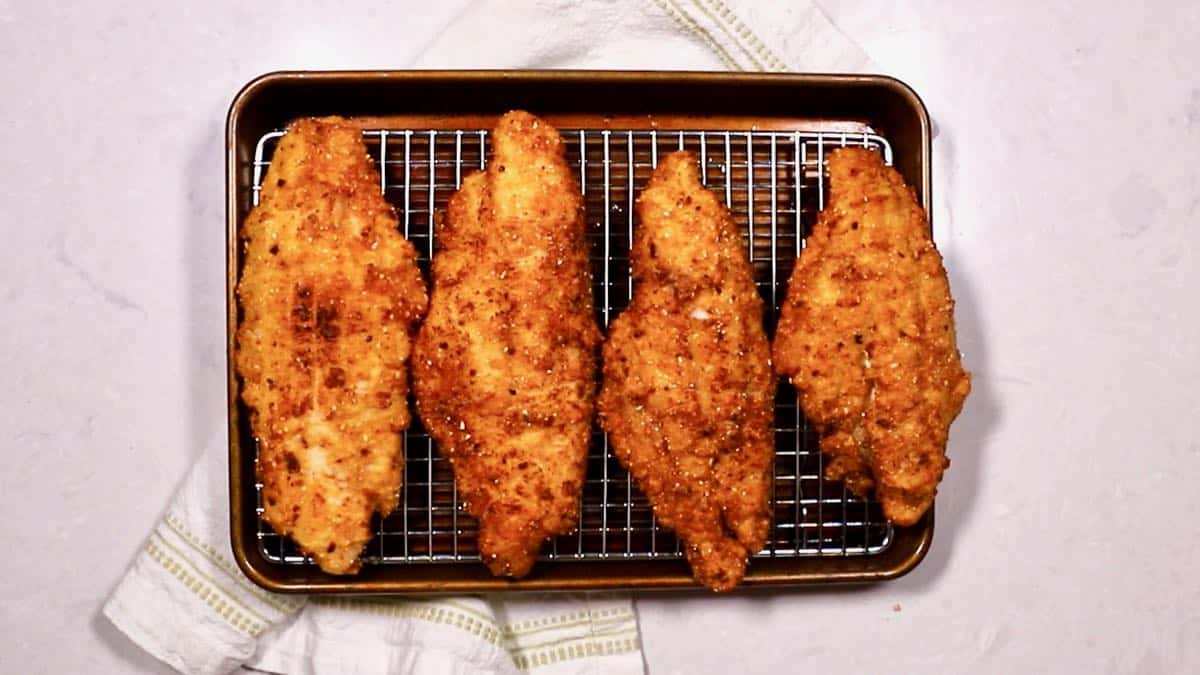
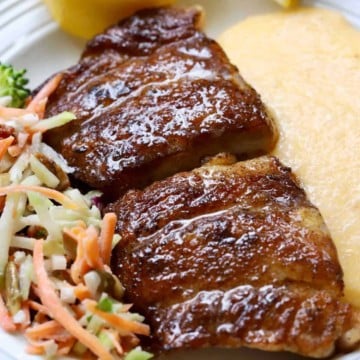
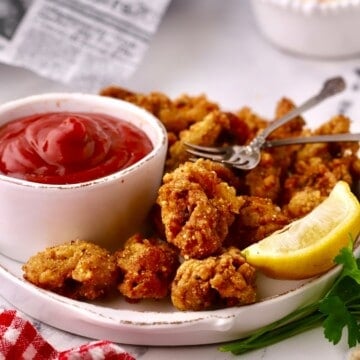
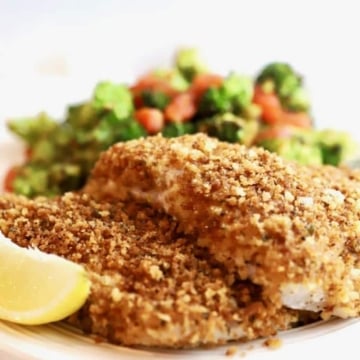
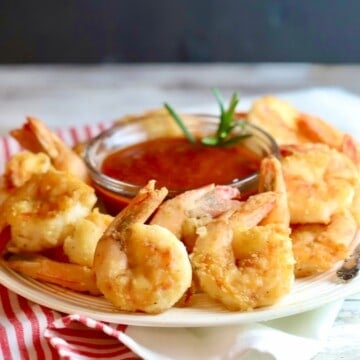
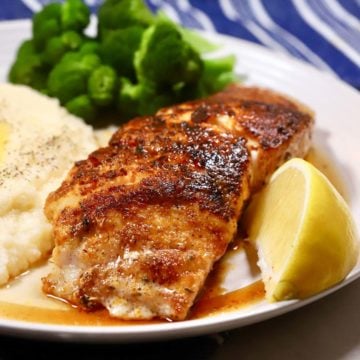

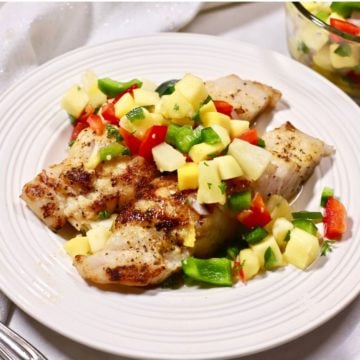
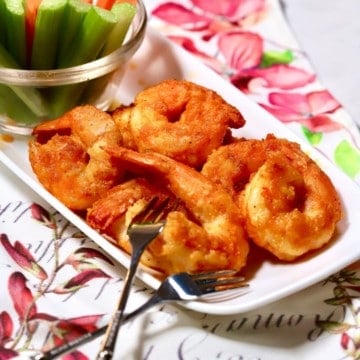
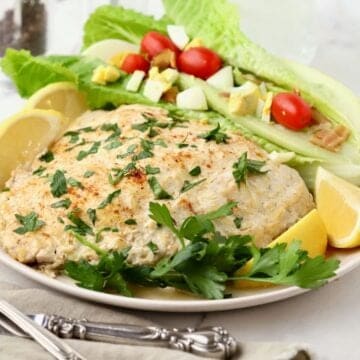

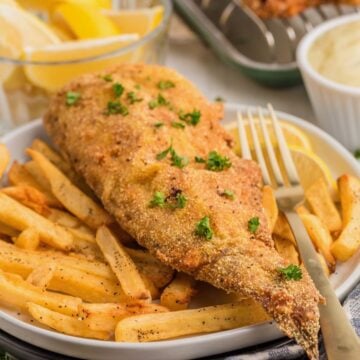
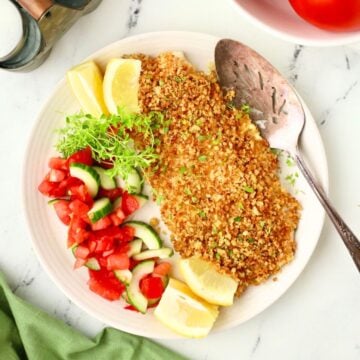

Beverly
This is a great recipe for fried fish. I used flounder filets and soaked the fish in buttermilk as the recipe directed. Also, to thicken up the breading a bit, I also had a bowl of buttermilk and egg combined and double-dipped my filets, for extra crispy fish. I will use this fried fish recipe from now on. Enjoy your blog very much, so nice to find recipes from a Southern cook!!
Sharon Rigsby
Hi Beverly, thank you so much for your kind words. I am so happy you enjoyed this recipe and that you customized it to meet your needs. Thanks too, for taking the time to write and let me know.
All the best,
Sharon
Karyes Stockdale
I would love to order some of that corn meal, what do I need to do?
619-654-0041
Sharon Rigsby
Hi Karyes, I use a locally ground cornmeal from Bradleys Country Store. Here is a link if you would like to order some: https://bradleyscountrystore.com/product/cornmeal/
All the best,
Sharon
Gerry
Had these last night for the second time. So good and easy to make even without a deep fryer. I used Perch because it’s my favorite. I used my own spices because I love Cumin and Nutmeg in fish batter. I have reduced the amount of cornmeal and flour each time and stull had a lot left over. Seemed like a waste, especially when using my spices. I’ll have it just right next time around. Thank you for these recipes. I will be preparing many of them. Looking at you Fried Oysters.
Sharon Rigsby
Hi Gerry,
I’m so glad you liked this recipe, and I know you will love the fried oysters too! I’m intrigued with the cumin, nutmeg spice combination and will have to try that soon! Thanks so much for leaving a comment!
All the best,
Sharon
Gerry
I think nutmeg is a Korean thing, not sure though. Korean seafood the 1st time I experienced noticeable nutmeg in the cornmeal, flour mixture. I happen to love cumin and the two go together well. Thanks again for the great recipes. I’m southern and these recipes take me back.
Nicole
Very good! I used Whiting fillets and added a pinch of baking soda for extra crispiness.